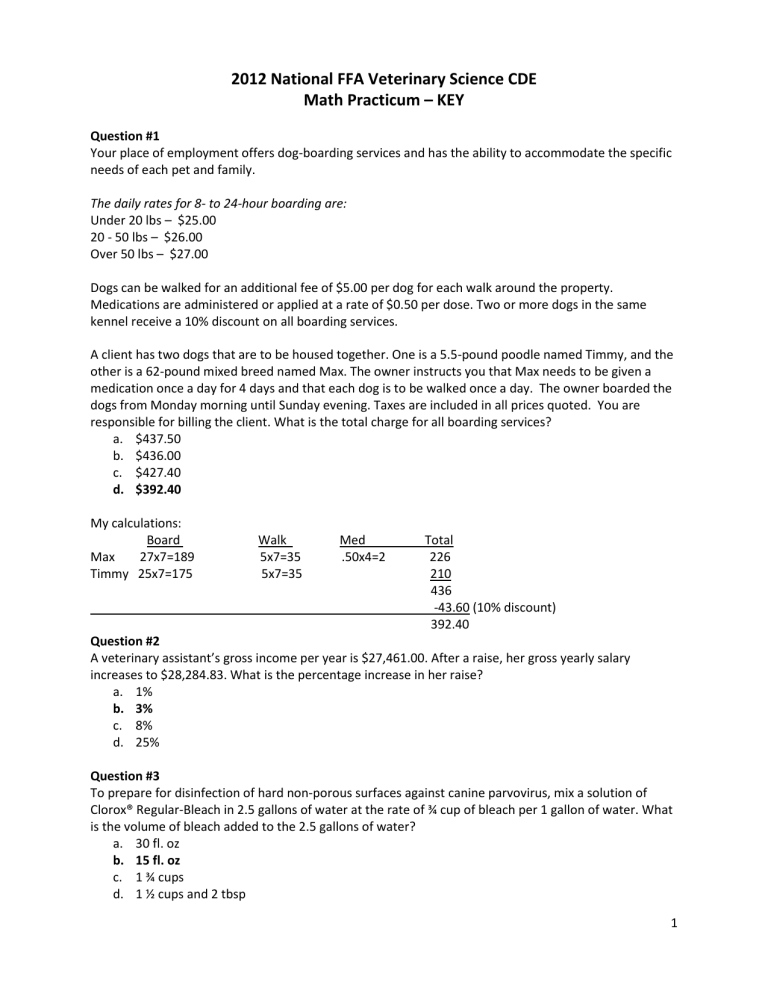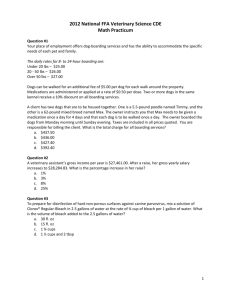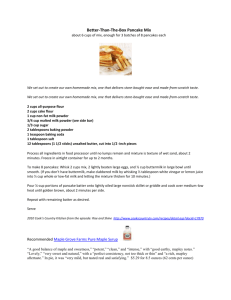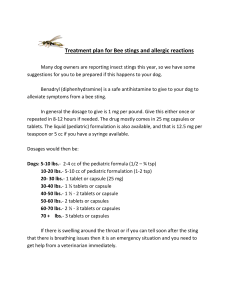2012 Math Practicum_Key

2012 National FFA Veterinary Science CDE
Math Practicum – KEY
Question #1
Your place of employment offers dog-boarding services and has the ability to accommodate the specific needs of each pet and family.
The daily rates for 8- to 24-hour boarding are:
Under 20 lbs – $25.00
20 - 50 lbs – $26.00
Over 50 lbs – $27.00
Dogs can be walked for an additional fee of $5.00 per dog for each walk around the property.
Medications are administered or applied at a rate of $0.50 per dose. Two or more dogs in the same kennel receive a 10% discount on all boarding services.
A client has two dogs that are to be housed together. One is a 5.5-pound poodle named Timmy, and the other is a 62-pound mixed breed named Max. The owner instructs you that Max needs to be given a medication once a day for 4 days and that each dog is to be walked once a day. The owner boarded the dogs from Monday morning until Sunday evening. Taxes are included in all prices quoted. You are responsible for billing the client. What is the total charge for all boarding services? a.
$437.50 b.
$436.00 c.
$427.40 d.
$392.40
My calculations:
Board Walk Med Total
Max 27x7=189 5x7=35 .50x4=2 226
Timmy 25x7=175 5x7=35 210
436
-43.60 (10% discount)
392.40
Question #2
A veterinary assistant’s gross income per year is $27,461.00. After a raise, her gross yearly salary increases to $28,284.83. What is the percentage increase in her raise? a.
1% b.
3% c.
8% d.
25%
Question #3
To prepare for disinfection of hard non-porous surfaces against canine parvovirus, mix a solution of
Clorox® Regular-Bleach in 2.5 gallons of water at the rate of ¾ cup of bleach per 1 gallon of water. What is the volume of bleach added to the 2.5 gallons of water? a.
30 fl. oz b.
15 fl. oz c.
1 ¾ cups d.
1 ½ cups and 2 tbsp
1
Question #4
You have taken the body temperature of a market hog that reads 38 degrees Celsius. The owner of the hog does not understand Celsius and ask you to convert it to Fahrenheit. What is the converted body temperature? a.
100.4° F b.
104° F (incorrect answer on key) c.
102.5° F d.
98.8° F
My calculation:
38x9/5+32=F
342 +32 =F or 1.8x38+32=F
5
68.4+32=100.4
Question #5
You are directed to take a weight on a client’s dog. The English Mastiff named Sophia weighs 85.90 kg.
How much does Sophia weigh in pounds? a.
8.59 lbs b.
85.90 lbs c.
18.9 lbs d.
188.9 lbs
Question #6
What volume of drug is drawn into this syringe? a.
0.23 cc b.
2.3 cc c.
23 mm d.
23 ml
Question #7
The doctor diagnosed pinkeye in a 450-pound heifer calf and prescribed Nuflor® for the treatment. The dosage on the label is 20 mg/kg or 20 milligrams of drug per kilogram of body weight. The concentration of Nuflor® is 300 mg/ml. What dose of Nuflor® will be administered? a.
13.7 ml b.
137 ml c.
10.22 ml d.
4,100 ml
2
Question #8
The veterinarian informs you that the patient has a bite wound and will require antibiotics. A common antibiotic, cefazolin, is administered to help fight infection. Cefazolin is administered at a dosage of 22 mg/kg. The patient weighs 44 pounds. What is the dose of cefazolin for this animal? a.
0.44 mg b.
4.4 ml c.
440 mg d.
968 mg
Question #9
Selamectin is recommended for use in dogs 6 weeks of age and older. The directions state: “Apply to the skin once of month at the recommended minimum dosage of 6 mg/kg or 6 milligrams of selamectin per kilogram of body weight.” The product comes prepackaged in six tubes. Each dispensing tube contains
240 mg of selamectin. If the client’s dog weighs 88 pounds, how many months of treatment are in one package of selamectin? a.
2 months b.
3.25 months c.
5.5 months d.
6 months
My calculation:
88 lbs÷2.2 = 40 kg
6x40=240 mg daily dose – 1 tube
6 tubes = 6 mo
Question #10
How many milliliters (ml) are in 9 ounces (oz) of liquid? a.
2.70 ml b.
270 ml c.
900 ml d.
9000 ml
Question #11
The veterinarian has ordered 0.5 gram of cefazolin to be given intravenously (IV). Cefazolin is packaged in a dry form of 1 gram, and the package directions state to add 2.5 ml sterile water to reconstitute the dry volume to a liquid volume of 3 ml. How many milliliters of the suspension contain 0.5 gram of cefazolin? a.
.5 ml b.
0.15 ml c.
1.5 ml d.
150 ml
3
Question #12
The doctor’s order reads: “Amoxicillin 225 mg p.o., q12 hrs.” The bottle from pharmacy is labeled: “250 mg = 5 ml.” How many milliliters would you give per dose? a.
0.45 ml b.
4.5 ml c.
45 ml d.
450 ml
Question #13
Indicate the number of tablets prescribed for the following order:
Rx: Metronidazole tablets 50 mg
Sig: 2 tablets, P.O., BID x 10 days a.
10 tablets b.
20 tablets c.
30 tablets d.
40 tablets
4
Answer Key: 2012 National Vet Science Math Practicum
1) D. $392.40
2) B. 3%
3) B. 15 fl. oz
4) A. 100.4° F
5) D. 188.9 lbs
6) D. 23 ml
7) A. 13.7 ml
8) C. 440 mg
9) D. 6 months
10) B. 270 ml
11) C. 1.5 ml
12) B. 4.5 ml
13) D. 40 tablets
5
2012 National Vet Science Math Practicum
Common Conversions
2 tbsp = 1 fl. oz. = 30 ml
1/4 cup =2 fl. oz. = 60 ml
1/2 cup = 4 fl. oz. = 125 ml
1 cup = 8 fl. oz. =250 ml
1 1/2 cups =12 fl. oz. = 375 ml
2 cups or 1 pint = 16 fl. oz. =500 ml =1 pound
4 cups or 1 quart = 32 fl. oz. = 1000 ml or 1 liter
1 gallon =128 fl. oz.= 4 liters
2 pints =1 quart
4 quarts = 1 gallon
60 grains (gr) = 1 dram (dr)
3 teaspoons = 1 tablespoon = 1/2 ounce = 14.3 grams
2 tablespoons =1/8 cup =1 ounce = 28.3 grams
4 tablespoons =1/4 cup =2 ounces =56.7 grams
5 1/3 tablespoons =1/3 cup =2.6 ounces= 75.6 grams
8 tablespoons = 1/2 cup = 4 ounces =113.4 grams
12 tablespoons = 3/4 cup =6 ounces = .375 pound
32 tablespoons =2 cups = 16 ounces = 1 pound
1 teaspoons (t)= 5 milliliters
1 kilogram (kg) = 2.2 pounds
1 pound = 453.59 grams
Fahrenheit = Celsius * 9 / 5 + 32
1 millimeter (mm) = 0.001 of a meter
6




